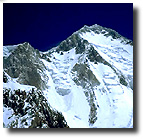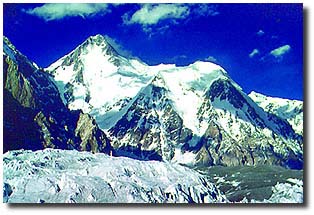Hidden Peak
 Gasherbrum I - Hidden Peak Gasherbrum I - Hidden Peak
 The first references of Gasherbrum I
exist as early as 1861 by Lt. H. H. Godwin
Austen. The mountain height was determined during
a period 1889-1929, while it was photographed for
the first time also by an English expeditioner M.
Conway, during this time the mountain was named
"Hidden Peak" due to its remoteness and
sharp pyramid formations. The first references of Gasherbrum I
exist as early as 1861 by Lt. H. H. Godwin
Austen. The mountain height was determined during
a period 1889-1929, while it was photographed for
the first time also by an English expeditioner M.
Conway, during this time the mountain was named
"Hidden Peak" due to its remoteness and
sharp pyramid formations.Geographical position: Greater
Karakoram, Baltoro Mustagh
Longitud: 76¡ 42E.
Latitude: 35¡ 43N.
Height: 8068 m.
More on the massive ...
|

Gasherbrum I |
The first attempt to climb Hidden Peak was
made 1934 by an international expedition, the first to
succeed to the top was done July 14 th 1958 by an
American expedition - Andrew Kauffman and Pete Schoening
(USA).
 "The
14 Giants" "The
14 Giants"
Hidden Peak is amoung the peaks that
have been called " The 14 Giants".
| Nr |
Moutain |
Meters |
Feet |
Country |
| 1 |
Everest |
8848 |
29028 |
Nepal/Tibet |
| 2 |
K2 |
8611 |
28250 |
Pakistan/Kina |
| 3 |
Kangchenjunga |
8586 |
28169 |
Indien/Nepal |
| 4 |
Lhotse |
8516 |
27940 |
Nepal/Tibet |
| 5 |
Makalu |
8463 |
27766 |
Nepal/Tibet |
| 6 |
Cho Oyu |
8201 |
26906 |
Nepal/Tibet |
| 7 |
Dhaulagiri |
8167 |
26795 |
Nepal |
| 8 |
Manaslu |
8163 |
26781 |
Nepal |
| 9 |
Nanga
Parbat |
8125 |
26660 |
Pakistan |
| 10 |
Annapurna |
8091 |
26545 |
Nepal |
| 11 |
Gasherbrum
I |
8068 |
26470 |
Pakistan/Kina |
| 12 |
Broad
Peak |
8047 |
26400 |
Pakistan/Kina |
| 13 |
Shisha
Pangma |
8046 |
26307 |
Tibet |
| 14 |
Gasherbrum
II |
8035 |
26360 |
Pakistan/Kina |
|
 Hidden
Peak - Special dates... Hidden
Peak - Special dates...
| 1861, 1887 |
Lt. H. H. Godwin Austen and Lt. F.
Younghusband, individually give out the first
references to Gasherbrum I. |
| 1889-1929 |
Gasherbrum I is measured and
photographed by Brittish and Italien explorers.
M. Conway coins the expression Hidden Peak, in
regards to the mountains pyramid shape, to beable
to differ it from Gasherbrum II. |
| 1934 |
An international expedition under
the guidence of Swiss alpinist G.O. Dyhrenfurth
conducts a thorough exploration of Hidden Peak.
I.H. Ertle and A.Roth climb along the
southwestern side up to about 6300m. |
| 1936 |
Logistic problems and strike among
the sherpas forces a france expedition, led by H.
De Segogne, to abort at 6900m (south side). |
| 1958 |
The first successful climb to the
top of Hidden Peak is completed by an American
expedition under the supervision of N. Clinch and
P. Schoening. July 5 P. choening and A.Kauffman
reach the top by following the southeastern ridge
and Urdok Comb. The final part of the climb is
difficult with extreme cold and very deep snow,
the members of the expedition wish they had
brought along skiis and snow shoes.
|
| 1975 |
As a two-man expedition with only 12
carriers (sherpas) to the base camp. R.Messner
and P. Habeler august 10, climb along the north
side to the top. The climb is done according to
the classical alpine style and is completed
without oxygen. |
| 1977 |
The fourth expedition to the top of
Gasherbrum I is done by a two man team existing
of A. Stremfelz and N. Zaplotnik. They are the
first to reach the top via the southwestern
ridge.D. Breger disappears following an attempt
to reach the top alone. |
| 1980 |
A French expedition is the fifth to
reach the top and is also the first to climb the
south ridge. |
| 1981 |
A Japanese expedition completes the
sixth attempt. |
| 1982 |
G. Sturm, M. Dacher and S. Hupfauer
from a German expedition reach the top by
following a new route along the north side. From
a French-Swiss expedition, under the leadership
of S. Saudan, 5 people, there amoungst Saudan and
his wife (as first woman) reach the top.Saudan
skiis back to the base-camp from the top. This is
the first decline from a 8000m high mountain. |
| 1983 |
A
Swiss expedition successfully climbs 3- 8000m
mountains in a row. Gasherbrum II, Gasherbrum I,
Broad Peak. A groupe existing of 9 members, E.
Loretan, M. Reudi and J.C. Sonnenwyl climb all 3
peaks in classic alpine style. Today there are over 6
different ways to the top and just as many
varieties.
|
|


